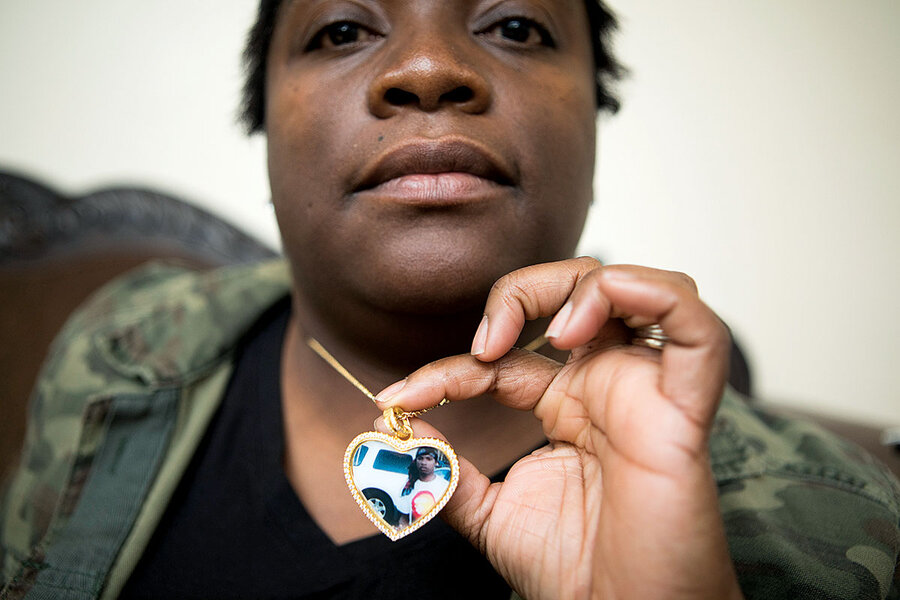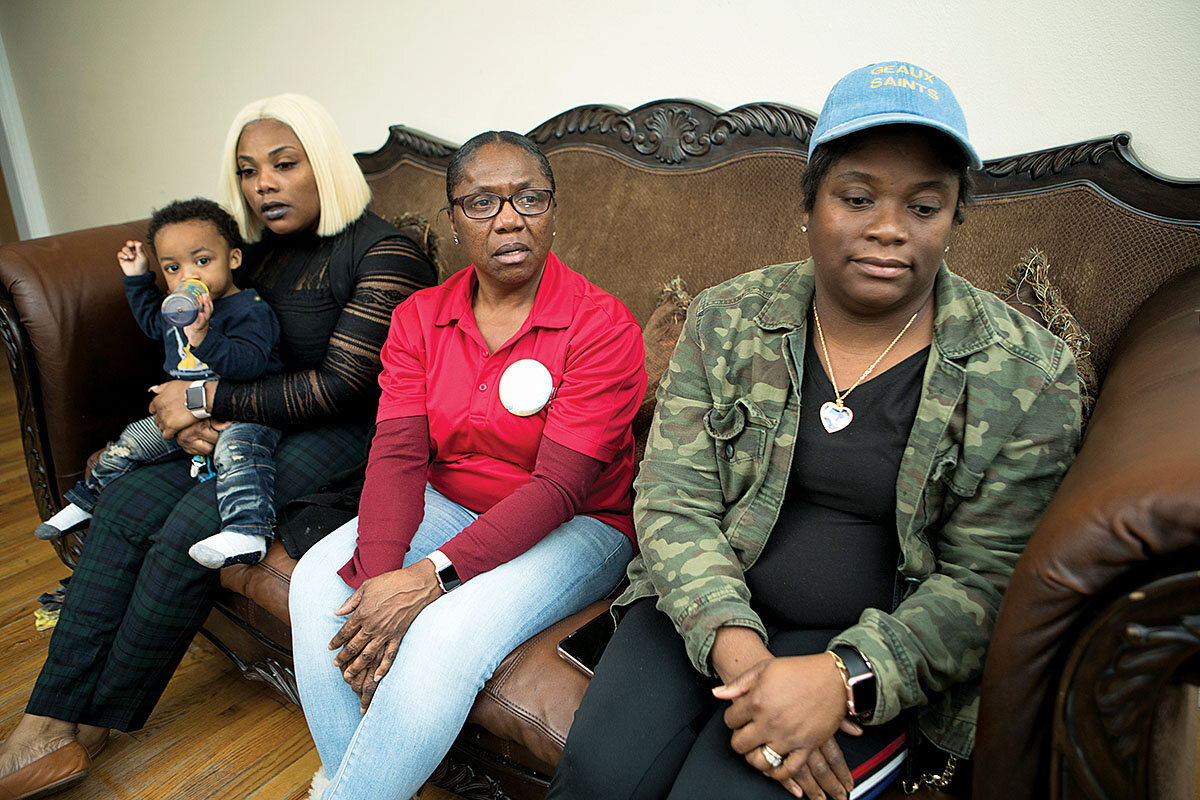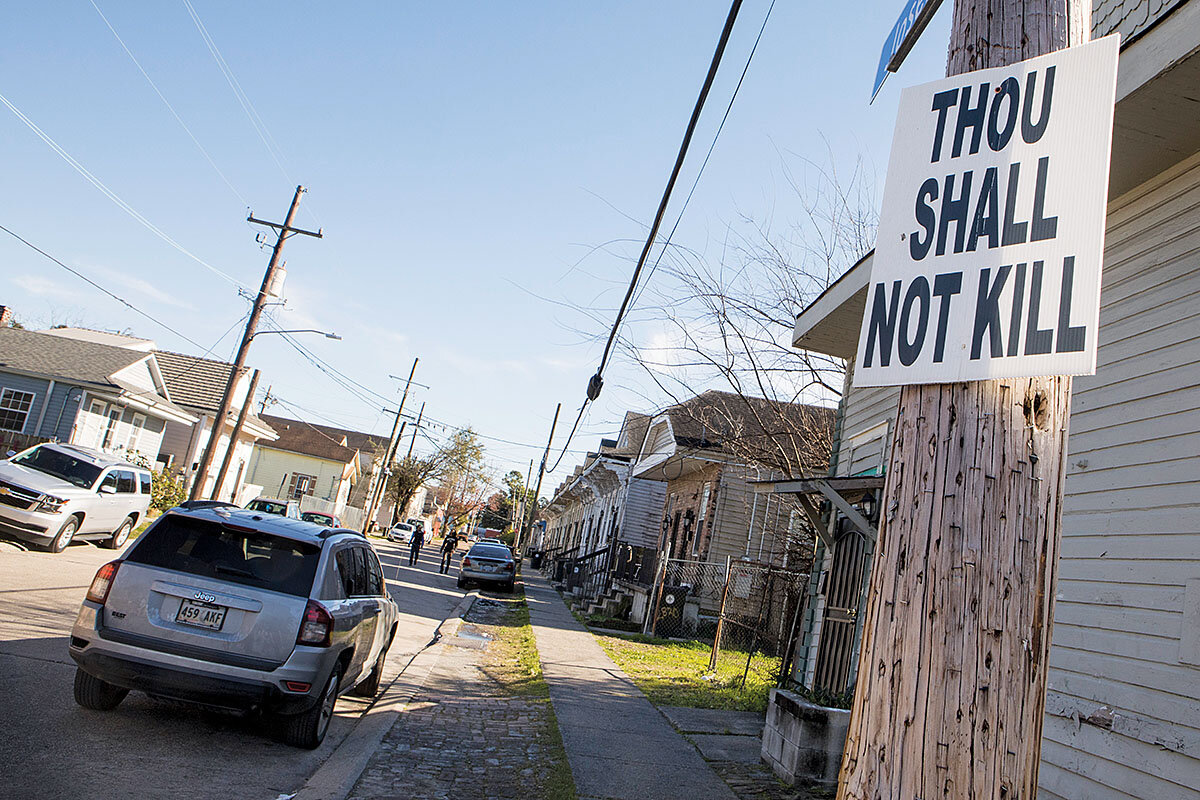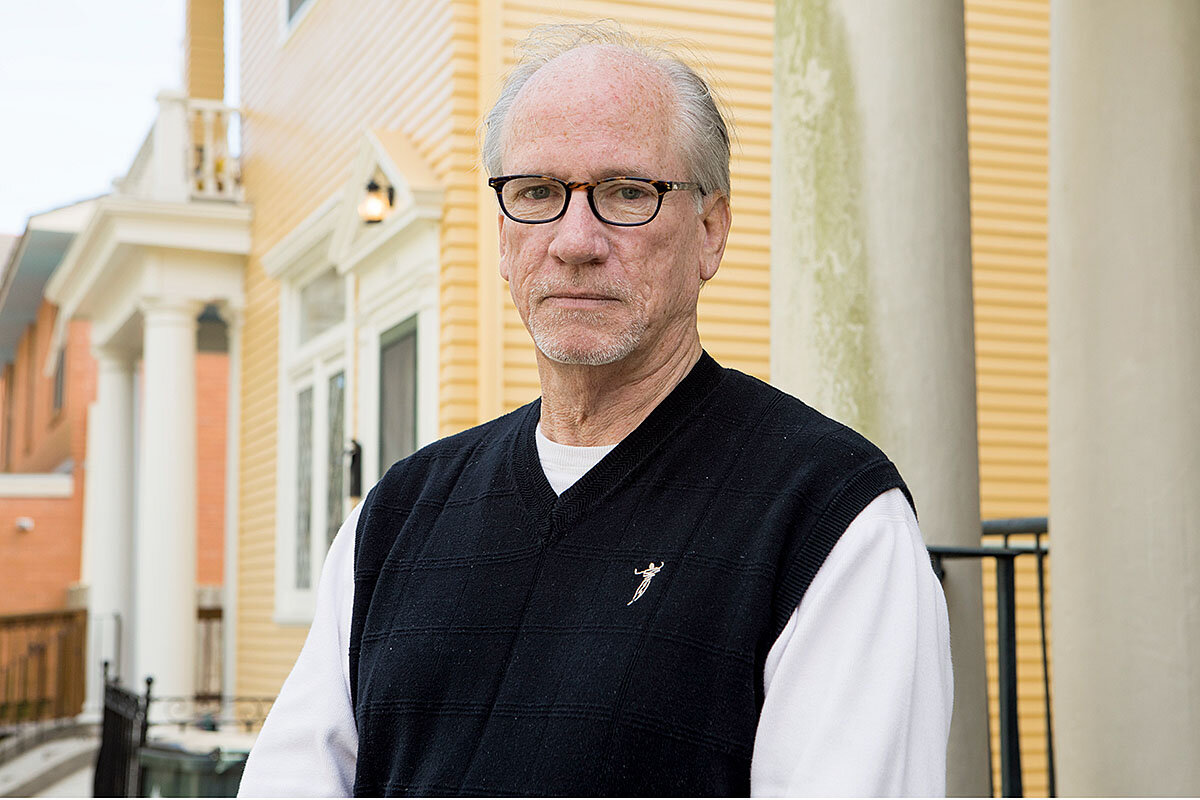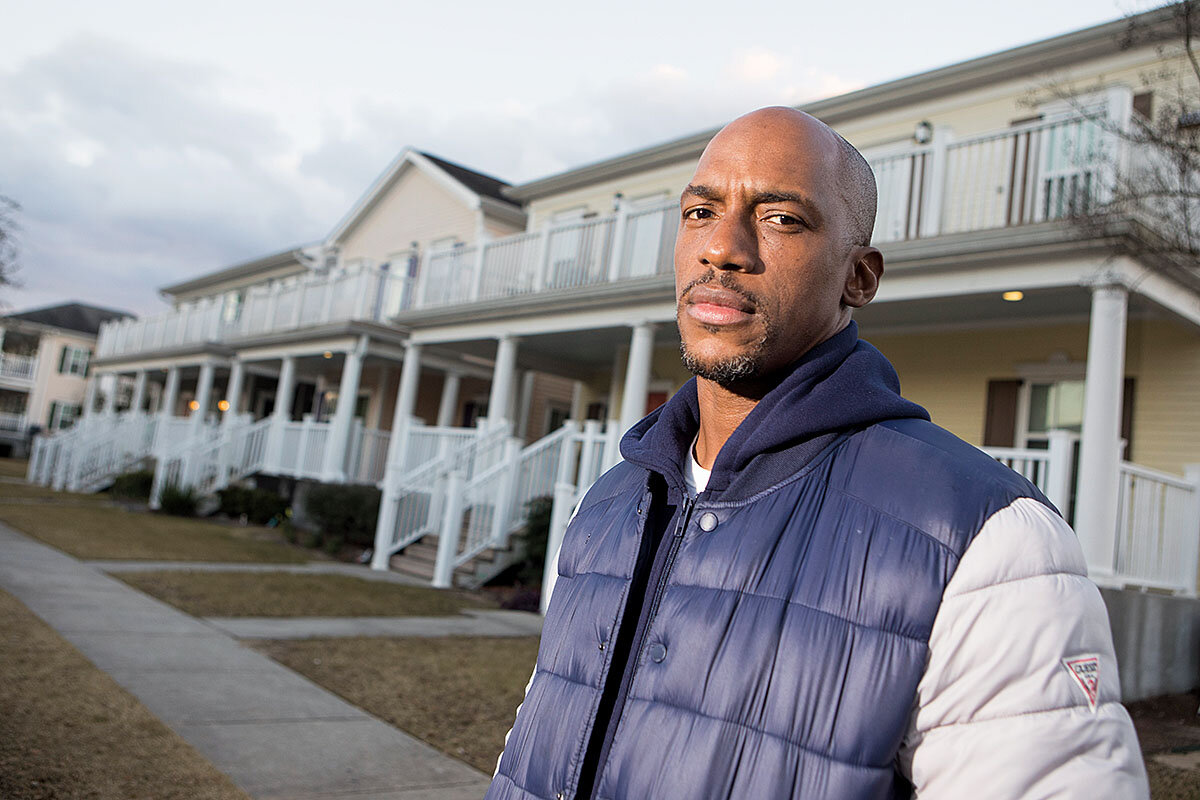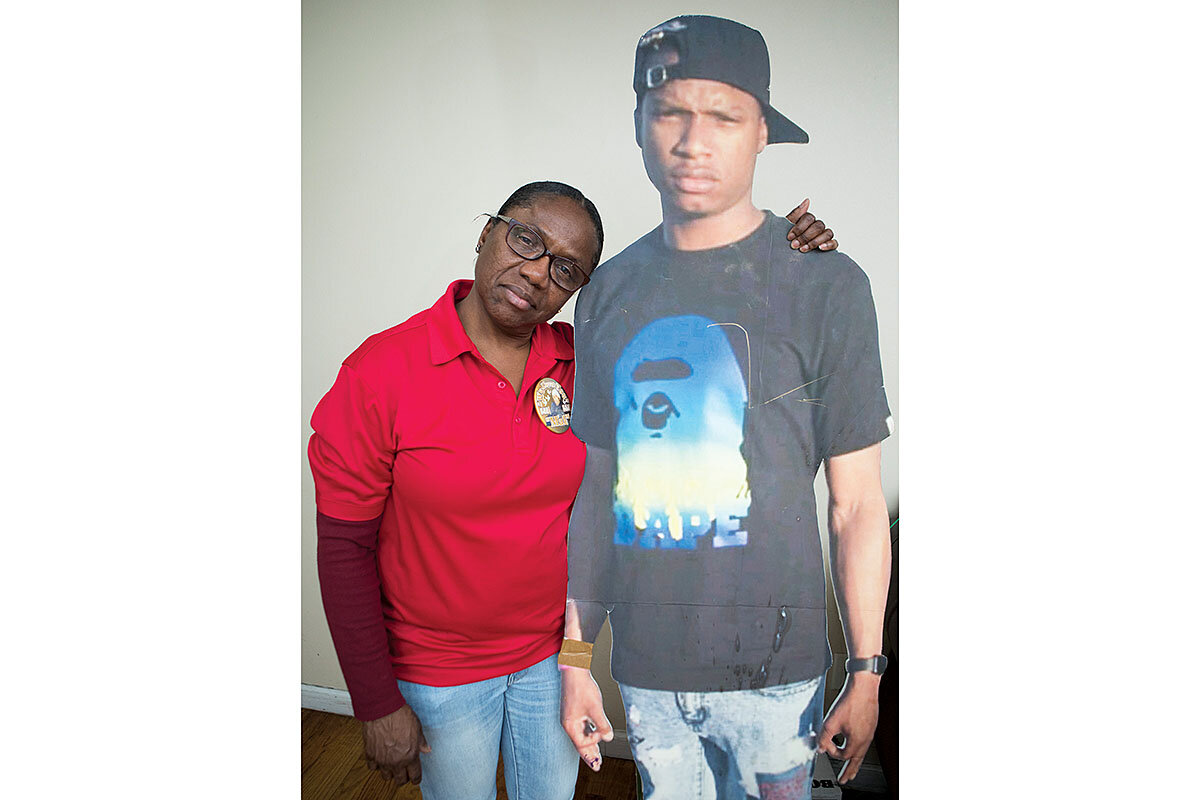Solving the unsolved: How cities are turning up heat on cold cases
| NEW ORLEANS
Shortly after a Mardi Gras parade a year ago, a group of local residents decided to extend their revelry and congregate in the Lower Ninth Ward here outside the Robinsons’ house. As their activities wound down around 8 p.m., two young black men approached in a car. They rounded the corner onto St. Claude Avenue dressed in “matching” red, white, and black athletic wear, according to court documents.
Then came the horror: Police say the men opened fire with semiautomatic rifles. Children screamed, ran into the house, and hid in closets. Janice Robinson was standing in her doorway, watching bullets tear into a red Altima parked out front. More than 100 rounds were fired in all. It was too dark to see the shooters’ faces. They vanished quickly into the night. Amid the mayhem, the Altima pulled away from the curb, rolling slowly into a nearby gas station. When it was safe, Ms. Robinson raced over to the car with her niece. At first they saw their friend Byron Jackson in the front seat, shot in the head, but alive. Three other young men in the car had been wounded as well.
Then she discovered her beloved nephew, Jamar Robinson, slumped over in the backseat. Mr. Robinson, who had been a stand-out football player in high school, was unresponsive. Janice patted his face. “There was not a drop of blood on him, which was so strange,” she says. “There was some confusion about whether he had a pulse. But he was gone.”
Police combed the area the next few days, but no one immediately came forward to identify the shooters. As the first anniversary of that dark weekend approached, the Robinson family worried that Jamar’s killing was heading toward becoming one more example of a disturbing trend in the United States: the growth in the number of cold cases. “I just hope they can find who did it,” says Elisa Young, Jamar’s sister.
Across the country, unsolved murders are piling up on detectives’ hard drives. Driven by the changing nature of crime, a lack of staffing in police departments, and burgeoning caseloads, unsolved murders are rising inexorably in many American cities. More than 250,000 cold cases have accumulated since 1980. In 1965, US detectives routinely cleared nearly 90 percent of murder cases. Today, on average, 40 percent of homicides go unsolved, according to the FBI Uniform Crime Report.
The rising cold case rate carries major implications. It leaves a growing number of killers out on the streets, undermines safety in urban neighborhoods, and erodes confidence in the criminal justice system.
Yet the trend hasn’t gone unnoticed. A growing number of cities – including New Orleans – are putting more resources into solving past and present cases, and independent groups are springing up that are hiring retired gumshoes to help police detectives solve stubborn murders. There’s even been a major development in the Robinson case, which, if it pans out, might bring a modicum of closure to the family.
“Nobody in our entire family has ever been touched by this kind of violence,” says Judy Robinson, Jamar’s mother. “I wouldn’t wish this on any other mother.”
***
The first 48 hours of a murder investigation are critical. An investigative team sweeps in and establishes a framework that can be filled in with forensics and intelligence. In those first few days, witness recollections are fresh, the offender or offenders are scared and more prone to making a mistake. But as time grinds on, witnesses drop out or disappear. Memories fade. Clues become less concrete, and new cases demand detectives’ attention.
If hard evidence – fingerprints on a shell casing, for example – is lacking, witnesses become even more important when trying to build a case. The problem is that in many urban neighborhoods residents are hesitant to come forward, fearing retaliation or retribution. A cocoon of silence often envelopes the street.
“People clear out,” says former New Orleans homicide chief Jimmy Keen. “Nobody ever sticks around to talk.”
This is nothing new, of course. John Skaggs, a retired Los Angeles Police Department detective, points out that witnesses keeping quiet either out of fear or antipathy toward police is woven into the annals of US law enforcement going back to the Whiskey Rebellion in the 1790s.
But crimes and policing are changing today in ways that are exacerbating the problem. In decades past, neighborhood residents would notify police if there was a shooting or they thought there was going to be violence. Today, especially in many urban neighborhoods, gang members and others have become their own enforcers.
“Now a lot of times people are handling their own business on the street, and we only get called when there’s a dead body,” says Major Michael O’Connor, chief of Atlanta’s major crimes section. “Without witnesses, you have to backtrack to figure it out. Cases are more difficult by their nature today than they were before.”
A growing distrust between police and local residents often hampers investigations, too. Not long ago, Louisiana State University criminologist Peter Scharf was in a neighborhood testing a listening device that allows police to detect when gunshots are fired. “A guy walks up and says, ‘You guys really don’t like black people. That’s why you have all that technology. You don’t want to hang out with us.’ There was some truth to that,” Mr. Scharf says.
Others see the problems running far deeper than residents’ estrangement from police. In his work, Mr. Skaggs has consulted with more than 50 US police departments. What he’s found generally is a downward spiral of sometimes shoddy and lazy police work, societal indifference toward gang-on-gang crimes, and waves of violence traced to “street justice” – the chain of retributive killings common to murder zones.
“A big problem is that these homicide detectives aren’t spending enough time on the street,” says Skaggs. “They’re looking at their computer, at social media, everything except going to look for that live witness.”
Yet police practices alone aren’t to blame. Resources are lagging, too. In many cities, including Washington, there are a third fewer cops per resident on the force today than there were 10 years ago. And even when departments do get money, they are torn between spending scarce resources on beefing up neighborhood patrols or hiring more detectives to clear yesterday’s case files.
“We were asked by one mayor, ‘Why should I spend resources to solve homicides?’ ” says former Washington, D.C., Detective Eric Witzig. “That was a very good question.”
All this has led to expanding caseloads, even though violent crime is down in many US cities. In 2016, New Orleans cleared only 3 out of 10 murders. Detroit’s clearance rate was 15 percent. Skaggs says that within cities, in some of the “baddest neighborhoods,” departments might solve only 10 percent of the homicides.
The rise in caseloads is taking a toll on police morale. Often detectives get assigned a murder on Friday and another one on Monday, on top of having to investigate other kinds of deaths and officer-involved shootings.
As a result, being a detective is not always the coveted job on the police force it once was. In 1970s New Orleans, local cops say, detectives used to hang out in their nattiest attire in some of the trendiest restaurants in the French Quarter – they were the kings of Bourbon Street. Today, US detectives in murder-heavy cities such as Chicago, Memphis, and New Orleans are more apt to be desk jockeys who spend their days poring through ever-growing files of unsolved murders.
“I had a real tough guy who decided to quit,” says Mr. Keen, the former New Orleans homicide chief. “He told me, ‘The bodies keep following me around.’ ”
***
The Calliope housing projects in New Orleans got flooded in hurricane Katrina, so today suburban-style townhouses dot this part of town, which is also dominated by bodegas selling a local staple – catfish po’boys. Yet the tranquil scene on the streets masks something much more insidious underneath.
The Calliope, in fact, remains one of America’s most violent urban areas, a nexus of the heroin and fentanyl trade. Organized street gangs such as the Goon Squad and Birdman Gang compete for heroin-dealing territory. The Central City neighborhood, of which the Calliope is a part, represents a microcosm of the murder and silence-of-the-street mentality at the root of the “clearance crisis.” In the beginning of December, a body lay in one of the streets. On Christmas Day, the man who police believe killed him was found dead himself just around the corner. No one reported seeing anything, in either slaying.
Living in such neighborhoods “teaches you to fear,” says New Orleans scrap dealer Al Smith, who grew up in the Calliope, before, as he puts it, the AR-15 assault rifle replaced the “Saturday night special” as the local weapon of choice.
Recently, Ameer Baraka, the 30-something actor and producer, was walking down a street in the neighborhood when an older man on a bicycle called out to him: “Hey, Millie, how ya doin’?”
Millie is Mr. Baraka’s old nickname and, today, a dark alter ego. “Yeah, I was one of these guys,” says Baraka, a star of the TV series “American Horror Story.” Baraka killed a 14-year-old rival back when he was young, landing him in prison for several years for manslaughter.
Today he still comes back to the Calliope, in part to save it. He works with children’s after-school programs in a gym with a Muhammad Ali mural on the wall. He runs a foundation that tries to address the root causes of urban despair and acts as a mentor at local prisons.
The author of “The Life I Chose” says the cycle of violence can be stopped by solving one case at a time. The work of detectives is crucial to doing that, he believes, even though he was once on the opposite side of the law from them. “It is easy to beat a charge,” he says. “That is why [people] kill.”
He recalls one particular local drug don – “great guy until you crossed him” – who was seen committing murder in broad daylight. The witness, a barber, talked to the police. A few days later, the barber lay dead with 19 bullet wounds.
But the kingpin is now at the Louisiana State Penitentiary, the state’s maximum security prison nicknamed “Angola.” A white bicyclist happened to pass by and volunteered his account to the police. It was enough to win a conviction.
“It took a white guy to put this guy in prison,” says Baraka. “And he doesn’t have to worry. None of these guys know where he lives. We’re talking literally about two separate worlds.”
After the Christmas Day slaying, Lionel Piper, who introduces himself as a local clergyman, nailed homemade signs all over his Central City neighborhood, urging people to reject drugs and the murder that too often comes in their wake. The next morning the signs were all ripped down. Another church put up signs saying “Thou shall not kill,” using heavy-duty roofing nails. So far, they remain.
Mr. Piper takes time from meditating on his stoop to talk about the violence in his neighborhood. He says police can only do so much to curb the problem, though he believes clearing cold cases is worth the effort. To actually stop the killing cycle, he says, squinting into the sun, requires something deeper and more individually redemptive – “a harder look at God.”
***
Until that happens, cities will have to rely heavily on the efforts of law enforcement authorities. Public outcry over deaths such as Robinson’s is forcing police departments to recognize the importance of justice for all – even for young black men killed unceremoniously in the streets, and for their families. As part of that shift, police are seeing increasing value in the importance of solving cold cases.
Cities such as Savannah, Ga.; Memphis, Tenn.; and Charlotte, N.C., have all formed special cold case squads, bringing in older detectives to reexamine unsolved murders. Skaggs serves on one such group in Inglewood, Calif., that recently cleared several dormant cases solely by digging up old witnesses who suddenly had something new to say.
The Murder Accountability Project, a nonprofit that maintains the largest archive of homicides in the US, is pushing for reforms that could help police departments solve current and past murder cases. It is trying to convince “city mothers and fathers to provide the necessary resources to cops,” says Mr. Witzig, the former Washington detective, who is MAP’s vice chairman.
Chicago Police Superintendent Eddie Johnson announced in December he is adding 50 sergeants to oversee the homicide division “to ensure proper case management and provide supervision and mentorship to detectives.” That move came partly in response to a three-day span last August when 70 people either died or were wounded in 40 separate shootings, with police making arrests in only three of the cases.
In Boston, proliferating street cameras have proved useful to solving tricky gangland murders, helping the city increase its homicide clearance rate, while in Atlanta police have formed a “hat squad” of detectives. Named after the fedora-wearing sleuths of yesteryear, the group is using old-fashioned techniques to solve modern crimes.
“The main thing is, these cases don’t get solved behind people’s desks,” says Mr. O’Connor of the Atlanta Police Department. “People will tell you what happened, but you have to be out there to give them the opportunity to do so. They’re not going to come into headquarters and tell you.”
***
Halfway through 2018, New Orleans experienced a sudden slowing in the number of murders being committed on its streets. It gave the city’s detectives some breathing room to solve more cases. The Robinsons hope the investigation into their son’s death will be one of them.
On Jan. 22, a federal grand jury did indict two people in connection with the killing of Robinson and Mr. Jackson, the man in the front seat who initially survived the shooting but later died. It charged Kendall Barnes and Derrick Groves with two counts each of second-degree murder in the quintuple shooting outside the Robinsons’ home. That indictment joins another one containing multiple counts of felony drug trafficking and weapons charges against the two men.
Mr. Barnes’s lawyer says he has footage showing his client in the French Quarter just minutes before the shooting, making his presence in the Lower Ninth Ward all but impossible given the traffic on Fat Tuesday. Both men have pleaded not guilty to the charges.
The indictment details an extensive heroin and fentanyl ring, reinforcing what former New Orleans Police Superintendent Michael Harrison had earlier said when he called the case a murder “linked to vicious gang violence between people who know each other.”
That statement did not sit well with the Robinson family. Neither Robinson nor Jackson had criminal records. The family instead portrays Jamar Robinson as a gentle person who was a star safety in high school and played football in college as well. He had recently been approved for a mortgage and bought his first house. He had also gotten a special license that allowed him to transport hospital patients. He was, his family says, a good dad to his 2-year-old son.
Yes, he dressed with impressive street bling. But days before the shooting, he had mysteriously begun to give all his fashion items away, shocking his mother. After his death, the family found nothing left of his to clean out.
“This is bigger than the [New Orleans Police Department],” says his sister, Eugencia Green. “This is the justice system, the courts, the juries, our society. This is much bigger than Jamar’s death.”
Detective Maggie Darling with the New Orleans Police Department has been the main person handling the case, though the FBI has been heavily involved because of the use of an AR-15 and alleged links to an organized drug trade. She has not given the family much detail, but press reports suggest that someone came forward by mid-May of last year, identifying Barnes out of a six-person line-up – an exception to the no-snitch culture that may have led to fresh leads.
To Skaggs, such acts of civic duty underscore that “85 percent of the people in these neighborhoods are law-abiding people, who like and respect the police.”
The family plans to be in court when the trial gets under way, to show their faces to the jury, wearing pins with photos of Jamar.
During a recent visit to his grave, Judy Robinson turns on the video camera on her cellphone as she begins a conversation with Jamar. The headstone glimmers in the sun. Before the screen flickers out, she makes her son a promise.
“I will find you justice.”



